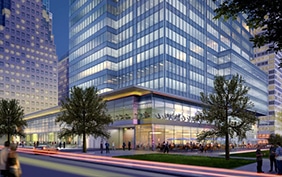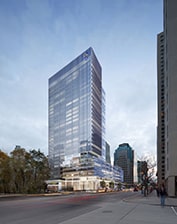Oxford’s WaterPark Place becomes first project to earn LEED Platinum recertification
Toronto, Ontario
March 9, 2014
- Rating System/Standard
- LEED v1
- Certification Level
- Platinum
- Building Type
- Office
WaterPark Place recently became the first project to get LEED Platinum recertification in Canada through CaGBC. We spoke to Andrew McAllan, Senior Vice President and Managing Director for Real Estate Management at Oxford Properties Group (and CaGBC Board Chair), about this achievement.
Project Team
- Project Owner/Developer
- CPP Investment Board Real Estate Holdings Inc. and Oxford Properties Group
- Architect
- WZMH Architects
- Mechanical Engineer
- MMM Group
- Electrical Engineer
- MMM Group
- Project Manager
- LEED EB project manager. Halsall Associates. Lead person was Emma Rohmann
- Commissioning Authority
- CFMS Consulting
Tell us about the project and its unique features, particularly those that led to it becoming the first Canadian LEED recertification.

WaterPark Place (10 & 20 Bay Street in Toronto) originally became certified LEED EB:O&M Gold in April of 2012, but we knew that over the course of 2013 and 2014, the complex would be transformed in coordination with the construction of RBC WaterPark Place, our sister building, which was pursuing LEED CS: Platinum certification. With the substantive financial outlay being put forward to re-establish WaterPark Place as a premiere commercial real estate destination, we knew we couldn’t rest on our laurels in relation to sustainability; that what we were doing on a ‘green’ level could be equally transformed in our pursuit of Platinum certification. The original design and construction of WaterPark Place provided a solid foundation for green operations, but with the development of RBC WaterPark Place, and our own improvements, we knew it was the perfect time for an upgrade.

Why did you choose LEED certification initially for this project, and why did you decide to pursue recertification?
LEED certification was originally pursued for WaterPark Place to acknowledge, improve and document the green practices and sustainable procedures already in place at 10 & 20 Bay. It gave us the opportunity to showcase ourselves in relation to our commercial real estate peers, and show how the complex illustrates (via our operations) a core Oxford mandate to run our buildings in the most sustainable way possible.
LEED is the acknowledged North American leader in benchmarking sustainable operations, so it seemed an appropriate designation to choose. As for recertification, as mentioned, it made sense to look to continue to transform our green policies and operations, just as the physical buildings were about to be transformed as well. Secondarily, it made financial sense for our customers as well – the outlay put forward to achieve new credits and ear recertification was projected to have a simple payback (in utility savings) of 1.5 to 2.5 years. This meant that LEED recertification made both environmental and fiscal sense.
What value does LEED certification bring to your building, both as an owner and/or property manager and for those the tenants who occupy it?

LEED certification demonstrates to our customers (our tenants) and our clients, to whom we owe the pension promise, that Oxford is operating the complex in the most sustainable way possible. Tenants today want to be in buildings that are operated in an environmentally responsible manner, it is codified in the leases. We could not have achieved the certification without the active participation from our tenants, so they can share in the pride of this achievement.
Participating in a program such as LEED is critical in understanding a path for the future. Down to the basics of measuring and quantifying energy being used, to the complex energy modeling for future Capital recommendations, these behaviours become the lynchpin in understanding a long-term governance plan for any building.
What was the biggest lesson learned from the recertification of a LEED project that you think would be valuable to other hoping to pursue LEED recertification?
Funnily enough, where we fail (and where credits were denied) provided the greatest lessons learned over the recertification process. You put processes in place and operations move forward, but even in the best circumstances things can be missed, misconstrued or forgotten, and your goals fall off the map. A constant re-commissioning of building systems gives results in energy savings and occupant comfort, but a constant scrutiny of policy and its execution on the front lines of operations ensures the philosophy we all support is working in real time. To others we would advise: never stop examining, measuring, analyzing – you will always find places to improve.
Is there anything else you’d like to add about your building or LEED in general?
The LEED process was a dynamic and exciting process, but it never ends. It is a constant commitment to best practices that allows all of us: owners, managers, and occupants, to know that the buildings we occupy are stepping lightly on the earth – and that WaterPark Place is a part of that commitment to all of our futures.